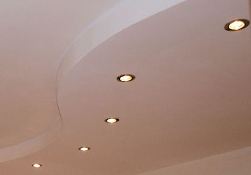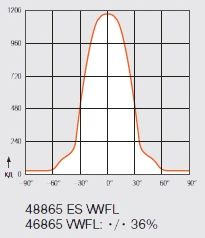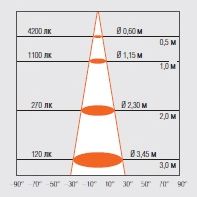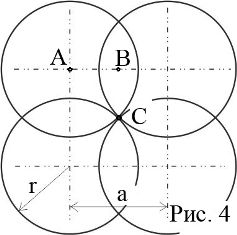Categories: Featured Articles » Sources of light
Number of views: 34436
Comments on the article: 1
Lighting calculation example for recessed luminaires with halogen lamps
Notes seller lighting. The simplest calculations.
 As an example of the calculation of illumination consider the use of luminaires built into a suspended ceiling. This case, on the one hand, is quite relevant, on the other hand, it is practically not described in classical manuals on lighting engineering and, finally, quite complete data on characteristics of halogen reflector lamps.
As an example of the calculation of illumination consider the use of luminaires built into a suspended ceiling. This case, on the one hand, is quite relevant, on the other hand, it is practically not described in classical manuals on lighting engineering and, finally, quite complete data on characteristics of halogen reflector lamps.
The OSRAM catalogs show not only such parameters as the axial luminous intensity and a flat angle corresponding to the solid angle, within which the luminous intensity drops by half, but also the curve of the angular distribution of luminous intensity (example in Fig. 1), as well as a visual image of the illumination as the distance from the lamp changes (Fig. 2).
Consider first the task of lighting a bathroom measuring 1.7 x 1.7 m2. Let's ask a question: What is the minimum number of halogen lamps that should be used to meet the requirements of existing standards and, in fact, which lamps should be used?
Illumination at floor level should not be lower than 50 lux. The height of the ceiling will be equal to three meters. Choose a halogen lamp with the widest angle (60 degrees) and axial illumination slightly exceeding 50 lux at a distance of 3 m. Such a lamp is OSRAM 46865 VWFL 35w. Its characteristics are shown in Fig. 1 and 2 (to obtain the absolute values of light intensity and illumination, the numbers given in the figure must be reduced by 36%).
Having performed the corresponding conversion, it is possible to build isophotes (lines of equal illumination) at the floor level, as shown in Fig. 3.

Fig. 1. The curve of the angular distribution of the luminous intensity of the halogen lamp OSRAM 46865 VWFL 35w

Fig. 2. Image of a change in light as the distance from the lamp changes
Isophotes lamps
As can be seen from this figure, the illumination level of 50 lux is achieved at the edges of the light spot with a radius of 1.43 m. Thus, if the room was round, then one halogen lamp would provide the required illumination on an area of 6.4 m2. Since the room is actually square, it is necessary to enter a square with a radius of 1.43 m, the side of which is A = 21 / 2R = 1.97 m, which is even slightly larger than a typical bathroom 1.7 × 1.7 m2.
It turns out that one OSRAM TITAN 35w lamp is enough to illuminate the entire room in accordance with the lighting standards! In practice, of course, this is not so. One lamp is certainly not enough. I have three lamps with such lamps in my bathroom of this size, and I can’t say that there is an excess of light.
Fig. 4. Halogen lamp OSRAM TITAN 35w
The reason, apparently, is that when using built-in lamps, the lighting conditions are very different from the use of, for example, pendant lights - the light almost does not hit the ceiling, the walls are poorly lit in the upper part. Hence, it is necessary to significantly, 3-4 times increase the requirements for illumination and It is advisable to combine the built-in ceiling lights with others, the light from which directly hits the ceiling.
Now we consider the task of lighting a large room with the required illumination of at least 200 lux at a height of 0.8 m from the floor with a ceiling height of 2.8 m. We choose a lamp with a maximum power of 50 W and again a TITAN with a wide angle of 60 degrees in order to reduce unevenness light distribution.
Using the same data as in the previous case, we find that a 50 W halogen lamp creates axial illumination at the considered height of 277 lux, and 50 lux at a distance of r = 1.58 m from the lamp axis.We place the built-in lamps with halogen lamps on the ceiling so that the isophotes corresponding to 50 lux of the four neighboring lamps are in contact, as in Fig. 5.
Fig. 5. Pairing isophotes of adjacent lamps of built-in lamps
Thus, at point A, illumination is created mainly by one lamp and amounts to 277 lux, at point C, the illuminances of four lamps are summed, which gives 200 lux, and at point B, the illumination created by two lamps is approximately the same as at point A. B In general, the unevenness of lighting can be estimated as (Emax-Emin) / (Emax + Emin) = 16%.
The distance between the built-in lamps with such a dense and uniform installation should be approximately 2 m. Using halogen lamps of lower power and placing them more often, it is possible to reduce the uneven distribution of light and, thereby, significantly increase comfort.
Kostyuk Alexander Vladimirovich
See also at bgv.electricianexp.com
:



